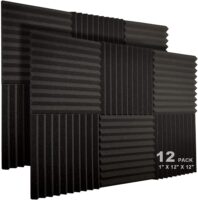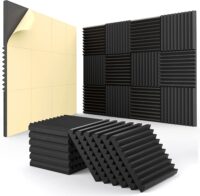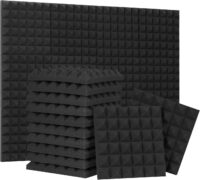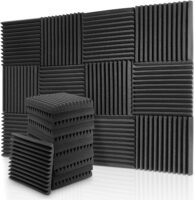Recording music is no easy feat. One way to ensure you get the best sound possible from your home studio or recording studio is by investing in acoustic panels to get the most accurate sound from your speakers. But without breaking the bank, what are the best budget acoustic panels?
We’re here to help with our guide so you can make sure your recordings have top-notch clarity and depth.
Learn why these panels are important for studios and what types of materials work best as well as tips on installing them yourself while staying within budget!
From finding the right instruments to getting good sound quality, there are a lot of factors that go into making great music in any setting.
But let’s look at my top 13 picks for the best options. Then below, I’ll answer all the most frequently asked questions.
1. Sonic Acoustics 12 Pack Hexagon Acoustic Panels – White
The #1 best-seller acoustic sound panels on Amazon with over 2400 great reviews. A 12-pack is under $30 and they are hex-shaped at 14″x 12″. .4 inches thick.
CLICK HERE to see the current price on Amazon.
2. Audiosoul – Studio Foam Wedges – Black
An Amazon’s Choice product with over 3000 great reviews. A 52-pack is under $40 and they are square 12″x 12″ tiles that are 1 inch thick.
CLICK HERE to see the current price on Amazon.
3. HPKL9999 Acoustic Panels Studio Sound Absorbing Foam Wedge Tiles – Black, Red, Blue, or Purple
An Amazon’s Choice product with over 2000 great reviews. A 48-pack is under $40 and they are square 12″x 12″ tiles that are 1 inch thick.
CLICK HERE to see the current price on Amazon.
4. XIN&LOG Acoustic Foam Panel Wedge Studio Soundproofing Wall Tiles – Black, Red, Blue, or Purple
An Amazon’s Choice product with over 6000 great reviews. A 48-pack is under $40 and they are square 12″x 12″ tiles that are 1 inch thick.
CLICK HERE to see the current price on Amazon.
5. DMSKY High-Density Self-Adhesive Sound Deadening Panels – Lots of color choices
An Amazon’s Choice product with almost 500 great reviews. An 18-pack is under $40 and they are square 12″x 12″. .4 inches thick. Self-stick means they will go up quickly and easily saving you hours of time.
CLICK HERE to see the current price on Amazon.
6. DEKIRU High-Density SoundProof Foam Panels – Lots of color choices
An Amazon’s Choice product with over 2,500 near-perfect reviews. A 12-pack is under $30 and they are hex-shaped at 14″x13″. .4 inches thick.
CLICK HERE to see the current price on Amazon.
7. JBER Acoustic Foam Panels – Black, Blue, Red, Charcoal
Over 4500 great reviews. A 12-pack is under $20 and they are square 12″x 12″ tiles that are 1 inch thick. Fire-resistant too.
CLICK HERE to see the current price on Amazon.
8. HEMRLY Self-Adhesive Quick-Recovery Sound Proof Foam Panels – Gray, Black-Gray, Carbon Black
An Amazon’s Choice product with over 500 great reviews. A 12-pack is under $30 and they are square 12″x 12″ tiles that are 1 inch thick. Self-stick means they will go up quickly and easily saving you hours of time.
CLICK HERE to see the current price on Amazon.
9. SOCODT Pyramid Designed Acoustic Foam Panels – Black
Over 800 great reviews. A 24-pack is under $40 and they are square 12″x 12″ tiles that are 2 inches thick. Self-stick means they will go up quickly and easily saving you hours of time.
CLICK HERE to see the current price on Amazon.
10. TroyStudio Acoustic Studio Absorption Foam Panel – Black
An Amazon’s Choice product with over 1400 near-perfect reviews. An 18-pack is under $35 and they are square 12″x 12″ tiles that are 2 inches thick.
CLICK HERE to see the current price on Amazon.
11. Donner SoundProof Foam Panels – Black
Almost 4000 great reviews. A 12-pack is under $30 and they are square 12″x 12″ tiles that are 2 inches thick.
CLICK HERE to see the current price on Amazon.
12. Focusound Soundproofing Noise Cancelling Wedge Panels – Black
Almost 1500 great reviews. A 50-pack is under $60 and they are square 12″x 12″ tiles that are 1 inch thick.
CLICK HERE to see the current price on Amazon.
13. HEWEIYHY Acoustic Panels Soundproof Studio Foam for Walls Sound Absorbing Panels – Black
An Amazon’s Choice product with over 4200 great reviews. A 50-pack is under $40 and they are square 12″x 12″ tiles that are 1 inch thick.
CLICK HERE to see the current price on Amazon.
Table of Contents:
- Why acoustic panels are important for recording studios
- How to choose the best budget option for your needs
- What types of material work best as acoustic panels
- Do-it-yourself tips for installing acoustic panels on a budget
- The benefits of using acoustic panels in your home studio
- FAQs in Relation to Best Budget Acoustic Panels
- Conclusion
Frequently Asked Questions
Why acoustic panels are important for recording studios
Acoustic panels are essential for recording studios, as they help to create a better sound quality.
They reduce unwanted echo and reverberation, which can make recordings muddy or unclear. Acoustic panels also improve the sound of playback, making it more enjoyable for listeners.
When setting up a recording studio, acoustic panels should be one of the first items on your list.
The best way to achieve optimal sound is by using acoustic treatments such as bass traps and diffusers in addition to acoustic panels. Bass traps absorb low frequencies while diffusers scatter high frequencies so that they don’t build up in certain areas of the room. This helps create an even frequency response throughout the entire space.
The size and shape of your room will determine how many acoustic panels you need and where you should place them for maximum effectiveness.
Generally speaking, larger rooms require more treatment than smaller ones do because there is more surface area that needs to be covered with absorption materials like foam or fabric-covered wall tiles. In general, aim for at least 20% coverage with absorptive material when treating large rooms (over 1000 square feet). Smaller rooms may only need 10%.
In order to get the most out of your acoustic panel setup, it’s important to consider both hard surfaces (such as walls) and soft surfaces (like furniture).
Hard surfaces tend to reflect sound waves back into the room rather than absorb them; this can cause echoes or reverberations that muddy up recordings or distort playback audio quality.
Soft surfaces absorb some of these reflections instead; this reduces their impact on overall sound quality significantly but still allows enough reflection for clarity in recordings/playback audio.
Finally, if you have a home theater set-up then adding some form of acoustical treatment is highly recommended. Acoustic treatments help reduce noise from outside sources entering through windows and doors while also reducing echo within the space itself, resulting in improved clarity during movie viewing sessions.
Acoustic panels are essential for recording studios to ensure that sound is captured accurately and without interference, providing a professional result.
A quick word about the NRC rating system:
NRC ratings refer to a measurement of how well sound gets absorbed by certain materials. And it’s a range between 0.00 to 1.00.
So when buying acoustic panels for your studio, especially when buying higher-end products, you may well see this rating on products. So here’s how to know what it means:
- Best – 0.90
- Better – 0.80
- Good – 0.70
In general, try and avoid anything under 0.70.
Of course, shooting for the “best” category is ideal, but that may not be the reality for your budget. But the more people and equipment in your studio, or a reflective surface that can reflect sound, the greater the need for a higher NRC rating.
The next heading will discuss the Best budget acoustic panels available on the market today.
How to choose the best budget option for your needs
When it comes to acoustic panels, budget is a major factor. It’s important to consider the size of your room and what type of material you want for your panels before making any decisions.
The larger the space, the more paneling you’ll need – and thus, the higher the cost will be. And are you intending on covering the entire room or only certain areas?
If you have a small room that only requires a few pieces here and there, then going with a budget option should suffice. Consider materials like fiberglass which are typically less expensive than wood or stone when shopping around for an affordable solution.
Another way to save money on acoustic panels is by purchasing pre-made kits instead of individual components. That’s one of the easiest ways to get your room done quickly.
Pre-made kits come with everything needed for installation including mounting hardware and instructions so they can easily be installed without professional help or extra tools. Plus, these kits often include soundproof foam which helps reduce noise in addition to improving acoustics in your recording studio or home theater setup.
If DIY isn’t your thing but you still want to save some cash on acoustic panels, look into buying used items from online marketplaces such as eBay or Craigslist where prices tend to be lower than retail stores due to their secondhand nature.
Just make sure that whatever item you purchase has all its parts intact and hasn’t been damaged in any way before committing!
Finally, if none of these options work for you then try looking into renting out equipment instead of buying it outright – this could potentially cut down costs significantly depending on how long you plan on using them for!
You can even rent out entire control rooms from certain companies if necessary – just make sure that they meet all safety regulations first before signing anything!
Overall, there are plenty of ways to find budget-friendly solutions when it comes to acoustic paneling.
However, one should not skimp too much on quality over price as this could end up costing more money down the line due to potential repairs or replacements being needed sooner rather than later.
By taking into consideration the size of your room, budget, and sound quality needs, you can find the best budget acoustic panels to suit your needs.
Next up, we’ll discuss how to install these panels for optimal results.
What types of material work best as acoustic panels
Depending on the size and shape of your recording studio or home theater, some options may work better than others.
One popular option is absorptive foam.
This type of material absorbs sound waves and helps reduce reverberation in the room. It’s lightweight and easy to install, making it an ideal choice for small rooms with hard surfaces such as tile or concrete floors.
The downside is that foam does not block out external noise very well, so if you’re looking for complete soundproofing this may not be the best option for you.
Heavy soundproof curtains are another great choice when it comes to acoustic panels.
They provide excellent sound absorption while also blocking out external noise from entering the room. Curtains come in a variety of colors and styles, so they can easily blend into any décor without being too obtrusive or noticeable in the space.
The downside is that they can be expensive depending on what type you choose and require more effort to install than other types of acoustic paneling solutions like foam or rugs.
Thick rugs are also an effective way to absorb sound waves within a room while providing extra insulation against outside noises as well as adding warmth and texture to your interior design scheme at the same time!
Rugs come in many different sizes, shapes, colors, and textures.
This allows you to customize them according to your own personal preferences – but keep in mind that thicker ones will offer more protection against unwanted sounds coming from outside sources than thinner varieties would do alone!
Finally an ATS Acoustic Panel is designed specifically for controlling high frequencies within recording studios or home theaters alike; these rigid fiberglass boards have been proven effective at reducing echo & reverberation levels which leads to improved clarity & accuracy during playback sessions!
Installation requires professional help due to their weight & size but once set up correctly – they’ll last years before needing replacement (if ever).
Before investing money into purchasing acoustic panels, make sure the material you decide upon fits both your budget needs and desired aesthetic appeal.
Acoustic panels can be made of a variety of materials, but the best budget options are usually foam or fiberglass. In the next section, we’ll discuss how to properly install acoustic panels for optimal sound quality.
Do-it-yourself tips for installing acoustic panels on a budget
Acoustic panels are an essential part of music studios, but they can be expensive. Fortunately, there are ways to save money when installing them on a budget. Here are four tips for getting the most out of your acoustic panel installation:
1. Choose the right material – When selecting materials for your acoustic panels, opt for dense options like foam or fiberglass instead of lighter materials like cloth. These will absorb sound more effectively and help reduce noise in your studio space.
2. Cut the panels to size – Cutting down larger pieces into smaller ones helps you get the most out of each piece while also making installation easier and faster.
This is especially important if you’re working with limited space or resources as it reduces wasted material and time spent cutting large pieces down to size by hand.
3. Use adhesive strips or hooks to attach the panels – Both adhesive strips and hooks make attaching acoustic panels easy and inexpensive, so choose whichever option works best for your walls or ceiling surfaces (e.g., drywall).
You can find these at most hardware stores in a variety of sizes and styles depending on what type of surface you’re working with (e.g., wood vs concrete).
4. Experiment with different placements until you find what works best – Different frequencies travel differently through air.
So experiment with placing bass traps in corners where low-end frequencies tend to accumulate while treble traps should be placed closer towards center points within rooms where higher frequency sounds occur naturally due to reflections off hard surfaces such as walls or ceilings .
Additionally, keep in mind that square footage matters when it comes to sound absorption; larger rooms require more acoustic treatment than small ones do since sound waves have further distances over which they must travel before being absorbed by materials such as foam or fiberglass insulation boards .
By following these tips, you can save money on your recording studio setup without sacrificing quality.
By following these tips, you can easily create an acoustic panel setup on a budget that will help improve the sound quality of your recordings.
Next, we’ll look at common materials used to make acoustic panels and their associated costs.
The benefits of using acoustic panels in your home studio
They can help reduce noise, absorb sound, and improve the overall sound quality of your recordings. By using acoustic panels in your home studio, you’ll be able to create a more professional look for your space while also improving the audio quality of your recordings.
One of the main benefits of using acoustic panels is that they can help reduce unwanted background noise from outside sources such as traffic or neighbors.
Acoustic panels work by absorbing sound waves before they reach the microphone or speakers, thus reducing reverberation and creating a cleaner recording environment. Additionally, acoustic panels can also help prevent feedback when recording with microphones by dampening high frequencies that may cause feedback issues.
Another benefit to using acoustic panels is that they can make small rooms feel larger and more spacious due to their ability to absorb sound waves rather than reflecting them back into the room as hard surfaces do.
This makes it easier for engineers to achieve better-sounding mixes without having to worry about excessive reverb or echo in their recordings. Additionally, acoustic paneling helps control low-end frequencies which are often problematic in smaller spaces due to standing wave buildup caused by parallel walls and other reflective surfaces within close proximity of each other.
When choosing what type of material works best as an acoustic panel for your home studio there are several factors you should consider including size, shape, color scheme, and budget constraints among others.
What are the best acoustic panels?
ATS Acoustic Panels offer great options for both large rooms as well as small ones with sizes ranging from 2×2 feet up all the way up 16 x 16 feet depending on how much coverage you need in order to get optimal results out of your recording sessions.
Bass traps are another great option if you want extra control over lower frequencies while foam wedges provide an easy way to cover entire walls without breaking the bank too much either!
Ultimately sound travels in different ways depending on the size and layout of your studio and how much stuff is in it. And if you try one thing and can’t quite get the sound right, don’t be afraid to try a different method.
Installing acoustic panels isn’t necessarily difficult but it does require some patience and attention to detail if you’re going at it alone without any assistance from professionals who specialize in this field (which we highly recommend).
For those looking for a DIY approach, however, there are plenty of online resources available such as instructional videos which will walk through every step necessary so even beginners will have no problem getting started right away!
In conclusion, adding some form of acoustical treatment to your home studio setup is always beneficial.
This could be anything from one wall covered with foam wedges to thick panels, to multiple bass traps strategically placed around corners – whatever fits best within budget constraints. Ultimately, these materials will help improve both aesthetics and audio quality significantly.
Acoustic panels can be an invaluable tool for creating a professional-sounding recording environment in your home studio. In the next section, we’ll discuss some of the best budget acoustic panels available to help you achieve that goal.
What are the most effective acoustic panels?
Acoustic panels are a great way to reduce unwanted noise and improve the sound quality of any recording space.
The most effective acoustic panels are those that absorb mid-to-high frequencies, such as foam or fiberglass, while also providing some diffusion of sound waves.
These types of panels can be hung on walls or ceilings to provide maximum coverage and absorption. Additionally, bass traps should be used in corners to help reduce low frequency reverberation. With these tools combined, you will have an optimized recording environment with clear audio for all your musical needs!
Are acoustic panels worth it?
Acoustic panels can be a great investment for musicians, music fans, recording studio owners and home recording enthusiasts.
They help to reduce unwanted reverberation and echo in the room, resulting in improved sound quality.
Acoustic panels also provide acoustic insulation which helps to keep outside noise from entering the space. In addition, they can improve aesthetics by providing an attractive wall covering that absorbs sound rather than reflecting it back into the room.
Ultimately, acoustic panels are worth it if you need better sound quality or want to reduce noise pollution in your space.

What is the cheapest soundproof material?
The cheapest soundproofing material available is mass-loaded vinyl.
It’s a flexible, lightweight material that can be used to line walls and ceilings in order to reduce noise transmission. Mass-loaded vinyl works by absorbing sound waves and preventing them from bouncing off of hard surfaces. It also helps to block out external noises like traffic or neighbors.
The cost of mass-loaded vinyl varies depending on the thickness and size needed for your project, but it is generally an affordable option for those looking for a budget-friendly way to soundproof their space.
What is the cheapest way to soundproof a room fast?
The cheapest way to soundproof a room quickly is to use acoustic foam panels.
These panels are made of polyurethane foam and can be easily mounted on walls or ceilings. They absorb sound waves, preventing them from bouncing off surfaces and creating echoes in the room. Additionally, they can help reduce outside noise coming into the space as well.
For maximum effectiveness, install multiple layers of acoustic foam at different angles around the room for better coverage. With this simple solution, you’ll have a much quieter environment without breaking your budget!
Conclusion
When it comes to sound quality, acoustic panels are an essential part of any recording studio or home theater.
With the right knowledge and budget-friendly options, you can easily find the best budget acoustic panels for your needs. Whether you’re looking for a DIY solution or professional installation, acoustic panels can help reduce noise and improve sound quality in small and large rooms alike.
So if you want to take your music production or home theater experience to the next level, consider investing in some high-quality acoustic panels today!
Are you looking for the best budget acoustic panels to help improve your music experience? Look no further! Music Nerds HQ has all of the solutions you need.
Our comprehensive collection of musical equipment, knowledge-packed trivia games and engaging history lessons will provide everything you need to make sure that your space is properly soundproofed without breaking the bank.
Get ready for a truly immersive audio experience with our top quality products – it’s time to get nerdy about music!
Image by Elad from Pixabay and Image by Dayron Villaverde from Pixabay
As an Amazon Associate I may earn a small comission from qualifying purchases if you click to Amazon from my site and choose to make a purchase. You can read my complete affiliate disclosure for more details.













